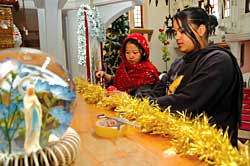 From the remote corners of Banke, Kailali, Dhangadi to the streets of Thamel, Nepali Christians are busy preparing to celebrate Christmas, their Dasain. Some Hindus and Buddhists as well will join in festivities on the big day.
From the remote corners of Banke, Kailali, Dhangadi to the streets of Thamel, Nepali Christians are busy preparing to celebrate Christmas, their Dasain. Some Hindus and Buddhists as well will join in festivities on the big day. Christmas is done in Nepali style. In the nativity scene, Baby Jesus is dressed up in a bhoto inside a doko, the Three Magis are decked up in daura suruwal. During the weekend prayer sessions, everyone takes off their shoes, squats on the floor and prays in Nepali. Even "praise the Messiah" is recited as "jai mahasi".
The New Testament was first translated into Nepali in 1821 by William Carey and is now being translated further into 12 indigenous languages. "Nothing is foreign about Christianity anymore," says church-goer Sujata Rai from Jawalakhel. "We are all one big family of Christians."
Christians have earned a positive reputation for involvement in social, health and education sectors, reaching out to the backward, poverty stricken and illiterate Nepalis in remote areas.
Among the best-known are the Jesuits who were one of the first to arrive after 1951 and they established themselves in the country by starting the boarding school, St Xaviers in Jawalakhel and Godavari. They were followed by the United Mission to Nepal (UMN), a collaborative body of several global missionaries. It made its own mark by establishing some of the best public and community hospitals, launching literacy programs, agriculture development activities and so on. It also became one of the first international NGOs to pioneer development work in Nepal. Today, it is the second-largest employer in Nepal after the government with the largest number of expatriate and Nepali staff working in UMN's projects around the country.
Other Christian charities like Caritas, International Fellowship (INF) and Nepal Leprosy Trust (NLT) have also been doing exemplary work in health and education-epsecially to reach marginalised communities who fall between the cracks. NLT is the only organisation that operates the leprosy services centre in southeast Nepal, that has the highest prevalence of leprosy. Over 20 percent of hospitals and clinics in Nepal are run by Christian charities.
The numbers of Christians in the country is growing. With less than 30 Christians in late 1950s, the number of believers increased to 200,000 in 1990 and now is estimated at one million, making up nearly four percent of the population and one of the fastest growing in the world. There are churches now in almost all the 75 districts of Nepal.
Among Christians, the Catholics have been working towards Nepalising Christianity. "Our religious differences do not affect our culture," explains Binod Gurung, president of Nepali Catholic Samaj. "We were brought up as Nepalis and have a close affinity with Hindu and Buddhist friends and we often celebrate each other's festivals."


